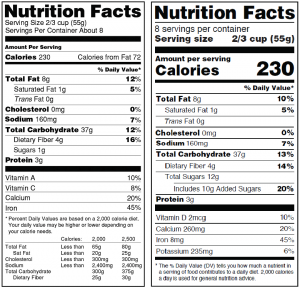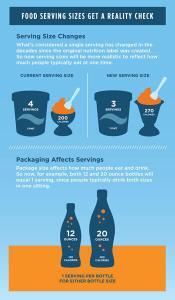The Food and Drug Administration (FDA) has recently made changes that will affect packaging for the food and beverage industry. These changes will be the biggest ones since the introduction of the Nutrition Label in 1990.
On May 20, 2016, the FDA announced the new Nutrition Facts label for packaged foods to reflect new scientific information, including the link between diet and chronic diseases such as obesity and heart disease. The new label will make it easier for consumers to make better informed food choices. FDA published the final rules in the Federal Register on May 27, 2016.
All food manufacturers with more than $10 million in annual sales must implement these changes by July 26, 2018. Manufacturers with less than $10 million in annual sales will have one year longer to implement theirs on July 26, 2019.
** On June 13, 2017, the FDA announced its intention to extend the compliance date for the Nutrition Facts Label final rules. The FDA will provide details of the extension through a Federal Register Notice at a later time.**
3 Major Changes for the New FDA-Compliant Nutrition Facts Label
Refreshed Design
 The “iconic” look remains, but updates will help ensure consumers easy access to the information they need. Some of the changes included are a larger type size, bolded font and more prominent placements. This is to put more of a focus on calories and servings per container. In addition to percent Daily Value, manufacturers must also declare the actual amount for vitamin D, calcium, iron and potassium.
The “iconic” look remains, but updates will help ensure consumers easy access to the information they need. Some of the changes included are a larger type size, bolded font and more prominent placements. This is to put more of a focus on calories and servings per container. In addition to percent Daily Value, manufacturers must also declare the actual amount for vitamin D, calcium, iron and potassium.
Updated Requirements for Nutritional Science
“Added sugars” must be included on the label. Along with past requirements for Calcium and Iron, Vitamin D and Potassium will also be required. Vitamins A and C will no longer be required, but can be included. “Calories from fat” is being removed.
Actual Serving Size
 Serving sizes will need to be based on the amount of food and beverages people actually are consuming, versus what they should be eating. So for packages that are between one and two servings, such as a 20 ounce soda or a 15-ounce can of soup, the calories and other nutrients will be required to be labeled as one serving because people typically consume it in one sitting. For certain products that are larger than a single serving but that could be consumed in one sitting or multiple sittings, manufacturers will have to provide “dual column” labels to indicate the amount of calories and nutrients on both a “per serving” and “per package”/“per unit” basis.
Serving sizes will need to be based on the amount of food and beverages people actually are consuming, versus what they should be eating. So for packages that are between one and two servings, such as a 20 ounce soda or a 15-ounce can of soup, the calories and other nutrients will be required to be labeled as one serving because people typically consume it in one sitting. For certain products that are larger than a single serving but that could be consumed in one sitting or multiple sittings, manufacturers will have to provide “dual column” labels to indicate the amount of calories and nutrients on both a “per serving” and “per package”/“per unit” basis.
While these changes might bring some unwanted angst, they also might make it a good time to rethink your packaging as a whole. View it as an opportunity to make changes in other areas to better serve your customers and maybe even retool your infrastructure.
The main takeaway is that these changes are coming and it’s best to get ahead of them before it’s too late. Now is the perfect opportunity to get ahead of your competition, re-evaluate and refresh your brand’s packaging.
Are you ready for these changes? If not, it’s wise to get started now. We can help.